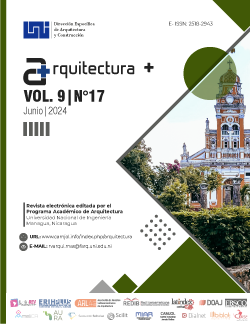Thermal habitability in educational spaces for infants during a heat wave in a arid climate, Torreon, Mexico
DOI:
https://doi.org/10.5377/arquitectura.v9i17.18220Keywords:
Adaptation, children-educational-spaces, thermal-habitability, heat-waves, healthAbstract
This work analyzes thermal habitability, as well as health impacts and forms of adaptation in a kindergarten located east of the city of Torreon, Coahuila, Mexico, during a seven day heat wave with temperatures above 40 °C in the summer of 2023, historically considered the warmest year on record in the world. For its execution, a mixed method was implemented that includes the collection and analysis of quantitative data from temperature records and qualitative data from interviews that interpret the subject's experience. The results indicate that the maximum temperatures inside the classrooms exceed the healthy thermal comfort ranges, since they were higher than 35 °C. For their part, the children expressed some physical and psychological difficulties caused by the intense heat inside the classrooms. Meanwhile, the building is not architecturally adapted to reduce the impacts generated by a heat wave.
Downloads
177
References
American Society of Heating, Refrigerating and Air-Conditioning Engineers - ASHRAE (1993). Fundamentals. Atlanta, EUA: ASHRAE.
Arsad F., Hod R., Ahmad N., Baharom M. & Ja'afar M. (2023). Assessment of indoor thermal comfort temperature and related behavioural adaptations: a systematic review. Recuperado de: https://pubmed.ncbi.nlm.nih.gov/37211568/
Auliciems, A. & Szokolay, S. (2007). Thermal comfort. Queensland, Australia: The University of Queensland.
Comisión Nacional del Agua - CONAGUA (2023). Reporte del clima en México. Junio 2023. Recuperado de: https://smn.conagua.gob.mx/tools/DATA/Climatolog%C3%ADa/Diagn%C3%B3stico%20Atmosf%C3%A9rico/Reporte%20del%20Clima%20en%20M%C3%A9xico/RC-Junio23.pdf
Consejo Nacional de Población - CONAPO (2020). índice de Marginación Urbana 2020. Recuperado de: https://www.gob.mx/cms/uploads/attachment/file/828844/urbana.pdf
Copernicus (2024). Nota de prensa. Bonn, 09/01/2024. Recuperado de: https://reliefweb.int/report/world/copernicus-2023-se-convierte-en-el-ano-mas-calido-desde-que-hay-registros-con-un-calentamiento-de-la-temperatura-global-proximo-al-limite-critico-de-los-15oc
De Lorenzo A., y Liaño, F. (2017). Altas temperaturas y nefrología: a propósito del cambio climático. Nefrología, 37, 492–500. DOI: https://doi.org/10.1016/j.nefro.2016.12.008
European Commission (2023). EU – Level technical guidance on adapting buildings to climate change. Best practice guidance. Recuperado de: https://op.europa.eu/en/publication-detail/-/publication/b175c9cb-cc5b-11ed-a05c-01aa75ed71a1/language-en
Fuentes, V. (2002). Metodología de diseño bioclimático: El análisis climático (Tesis de maestría). Universidad Autónoma Metropolitana, Unidad Azcapotzalco, Ciudad de México.
Gobierno de México (2023). Temperaturas naturales extremas. Temporada de calor 2023. Recuperado de: https://www.gob.mx/cms/uploads/attachment/file/858062/TNE_SE37.pdf
Gómez, L., Vargas, L. y Gómez, A. (2014). La búsqueda del placer en ambientes térmicos contrastantes, como una característica de la adaptación psicológica. Recuperado de: https://www.researchgate.net/publication/272682157_La_busqueda_del_placer_en_ambientes_termicos_contrastantes_como_una_caracteristica_de_la_adaptacion_psicologica_The_search_of_pleasure_in_contrasting_thermal_environments_as_a_feature_of_psychological
Gómez, G. y Gómez, A. (2015). Sostenibilidad y habitabilidad: ¿condiciones en pugna? En R. Valladares (Ed.), Diversas visiones de habitabilidad (39-70). Puebla: RNIU
González, A. J., Quiroa, J. A. & Villanueva, J. (2023). Habitar en un contexto de vulnerabilidad climática, durante una ola de calor en Torreón, Coahuila, México. Ciencia Nicolaita, s/v (87), 208-227. DOI: https://doi.org/10.35830/cn.vi87.700
Humphreys, M. & Nicol, F. (2018). Principles of Adaptive Thermal Comfort. Recuperado de: https://link.springer.com/chapter/10.1007/978-981-10-8465-2_10
Intergovernmental Panel on Climate Change - IPCC (2023). Comunicado de prensa. 23/06PR. Recuperado de: https://www.ipcc.ch/report/ar6/syr/downloads/press/IPCC_AR6_SYR_PressRelease_es.pdf
Magnusson, L. & Di Napoli, C. (2023). Heatwave over southwest Europe in August 2023. Recuperado de: https://www.researchgate.net/publication/374915387_Heatwave_over_southwest_Europe_in_August_2023
Martínez, P. y Patiño, C. (2012). Efectos del cambio climático en la disponibilidad de agua en México. Tecnología Y Ciencias Del Agua, 3 (1), 5-20. Recuperado de: http://www.revistatyca.org.mx/ojs/index.php/tyca/article/view/1
Mena, E. (2011). Habitabilidad de la vivienda de interés social prioritaria en el marco de la cultura. Cuadernos de Vivienda y Urbanismo, 4 (8), 296-314. Recuperado de: https://revistas.javeriana.edu.co/index.php/cvyu/article/view/5477
Morales, M., Nogués, M., Borrás, A. y García, Á. (2005). Golpe de calor. A propósito de un caso. Recuperado de: https://www.elsevier.es/es-revista-medicina-familiasemergen-40-pdf-13073963
Organización Panamericana de la Salud – OPS (2021). Olas de calor. Guía para acciones basadas en la salud. Recuperado de: https://iris.paho.org/bitstream/handle/10665.2/55244/9789275324080_spa.pdf?sequence=1&isAllowed=y
National Aeronautics and Space Administration - NASA (2024). anomalías de la temperatura global de la superficie en 2023. Recuperado de: https://www.nasa.gov/news-release/el-analisis-de-la-nasa-confirma-que-2023-fue-el-ano-mas-calido-registrado/
Pallasmaa, J. (2016). Habitar. Gustavo Gilli, Barcelona: España.
Picón, Y., Orozco, J., Molina, J. & Franky, M. (2020). Control central de la temperatura corporal y sus alteraciones: fiebre, hipertermia e hipotermia. MedUNAB, 23 (1), 118-130. Recuperado de: https://revistas.unab.edu.co/index.php/medunab/article/view/3714/3208
Quiroa, A., Villanueva, J., González, A. y Retana, A. (2020). Capacidad de mitigación de tres materiales constructivos de acuerdo con su desempeño térmico en zonas áridas, Caso de estudio: Torreón, Coahuila. Academia XXII, 11 (22), 216-231. DOI: https://doi.org/10.22201/fa.2007252Xp.2020.22.77413
Rahman, A. y Kojima, S. (2018). Study of indoor and outdoor thermal comfort for public space and houses in around river. Case study: Banjarmasin city, Indonesia. ADEIJ, 1(2), 29-41. Recuperado de: https://airccse.com/adeij/papers/1216adeij03.pdf
Rocque R., Beaudoin C., Ndjaboue R., et al. (2021). Health effects of climate change: an overview of systematic reviews. DOI: http://dx.doi.org/10.1136/bmjopen-2020-046333
Sarmiento, P., y Hormazábal, N. (2003). Habitabilidad térmica en las viviendas básicas de la zona central de Chile, a la luz de los resultados preliminares del proyecto FONDEF D00I1039. Revista INVI, 18 (46), 23-32. DOI: https://doi.org/10.5354/0718-8358.2003.62242
Secretaría de Educación Pública – SEP (2015). Acciones y programas. Recuperado de: https://www.gob.mx/sep/acciones-y-programas/administracion-federal-de-servicios-educativos-en-el-distrito-federal?idiom=es
United Nations Children's Fund - UNICEF (2022). El año más frío del resto de su vida. Proteger a la infancia frente al impacto creciente de las olas de calor. Recuperado de: https://www.unicef.org/media/130116/file/UNICEF-coldest-year-heatwaves-children-SP.pdf
United Nations Children's Fund - UNICEF (2023). El cambio climático está transformando la infancia. Un suplemento del índice de riesgo climático de la infancia. Recuperado de: https://www.unicef.org/media/147986/file/The%20climate-changed%20child%20-%20Report%20in%20Spanish.pdf
Villanueva, J. (2020). Zonas climáticas locales y uso de suelo en Torreón. Vínculos entre ciencia y política para el desarrollo urbano. Saltillo, México: Universidad Autónoma de Coahuila. DOI: https://doi.org/10.13140/RG.2.2.29556.17281
World Health Organization – WHO (2018). Heat and Health. Recuperado de: https://www.who.int/news-room/fact-sheets/detail/climate-change-heat-and-health
World Health Organization – WHO (2023). Significant weather and climate events in 2023. Recuperado de: https://wmo.int/sites/default/files/2023-12/Supplement.pdf
Downloads
Published
How to Cite
Issue
Section
License
Copyright (c) 2024 Universidad Nacional de Ingeniería

This work is licensed under a Creative Commons Attribution-NonCommercial-NoDerivatives 4.0 International License.



















